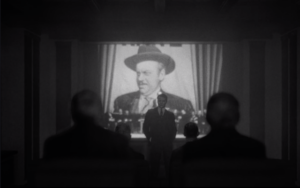AMERICAN: AN ODYSSEY TO 1947: 3 STARS. “expands the micro to the macro.”
 “American: An Odyssey to 1947,” a new documentary from director Danny Wu now on VOD, combines the artistic and ethical to form an intriguing portrait of the turbulent political landscape of the mid twentieth century in the United States.
“American: An Odyssey to 1947,” a new documentary from director Danny Wu now on VOD, combines the artistic and ethical to form an intriguing portrait of the turbulent political landscape of the mid twentieth century in the United States.
The film’s first half focusses on director Orson Welles, the wunderkind who, after taking the New York theatre world by storm in 1936 by staging a version of Shakespeare’s “Macbeth” with an entirely Black cast and creating a nationwide sensation with his radio adaptation of “The War of the Worlds,” moved to Hollywood and made one of the greatest films of all time, “Citizen Kane,” all before the age of twenty-five.
Although familiar to film fans, the story of how “Citizen Kane” landed in the crosshairs of newspaper magnate William Randolph Hearst is recounted here. The specifics of how the influential newspaperman used his political sway to torpedo the film and Welles’s Hollywood career, are intertwined with details of the director’s growing involvement in politics and progressive causes.
In 1947, with the House of Unamerican Activities showing more interest in him than Hollywood, Welles decamped for Europe. “America is not as happy with me as I am with it,” he said.
Wu then broadens the film’s focus to report how key moments of the time, the New Deal, World War II, the bombing of Hiroshima and racial injustice, played a part in shaping Welles’s political and personal life. Dropping the Hollywood biopic feel of the first half, Wu integrates the stories of Hiroshima survivor Howard Kakita, Isaac Woodard, an American soldier and victim of racial violence and Satsuki Ina, a psychotherapist born in an internment camp.
Disjointed though they may feel from time to time, these testimonials provide historical perspective and context for the over-arching look at the formation of Welles’s political awakening. Their stories are compellingly told, painting a grim picture of the hardship and inequity that informed the political climate of the time by expanding the micro to the macro.
What emerges is a portrait of an artist, influenced by world events, steadfast in his beliefs, even when those opinions threatened his career.
In “American: An Odyssey to 1947” Wu does a good job of setting up time and place, and even though the shift from career retrospective to the personal stories isn’t smooth, the film finds its balance to become an interesting, inventive recontextualization of a well-documented life.
